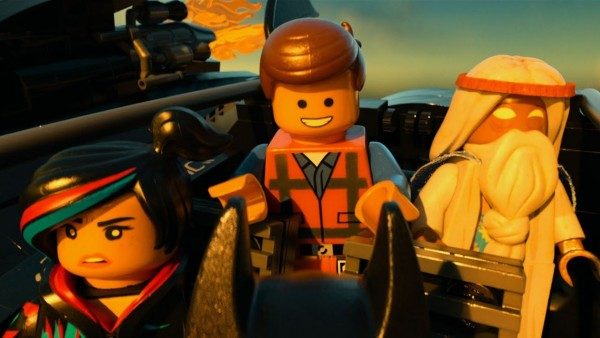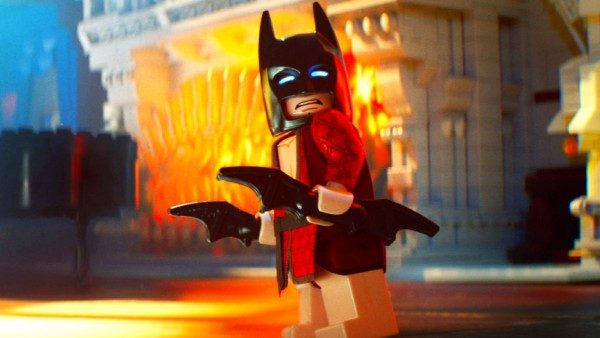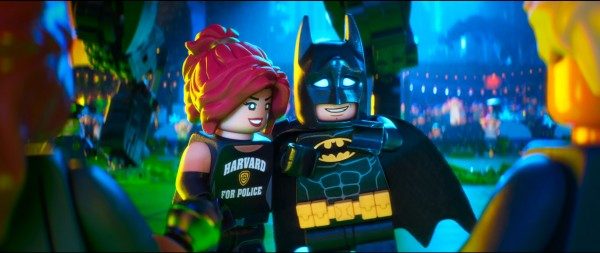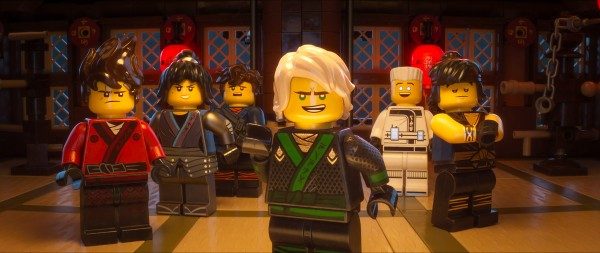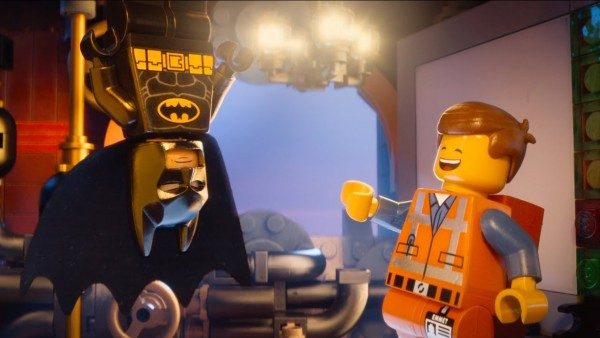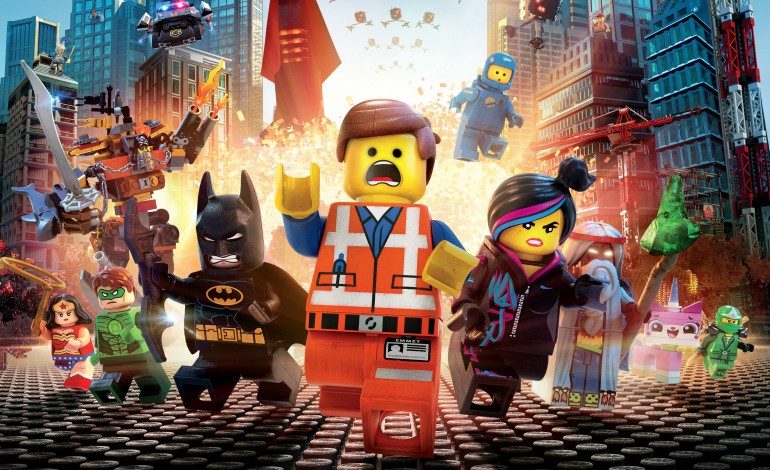

In an age where corporate power and consumerism seem to have reached their zenith, maybe it shouldn’t be surprising that one of today’s smartest, most culturally self-aware film franchises is based on a wildly popular children’s toy brand. Three years ago, Warner Animation Group’s The Lego Movie blew all expectations out of the water with its verbally-dense, self-parodying sense of humor, star-studded voice cast, and comically self-aware iterations of popular characters like Batman and Albus Dumbledore.
Since then, the Lego film franchise Warner Bros. has built has continued to thrive as a wellspring of meta comedy and pop culture critique, and though its newest entry (last week’s The Lego Ninjago Movie) may not feel quite as fresh and humorously sharp as its predecessors, the series shows no signs of holding back with its biting commentary on today’s film landscape and American culture as a whole.
This daring Lego endeavor began with writers Dan Lin and Kevin Hageman, who started working on a script for a Lego action-adventure film after Warner Bros. executive Kevin Tsujihara began to see cinematic potential in the brand. Filmmakers Phil Lord and Christopher Miller, fresh off of the unlikely success of their quirky animated feature Cloudy with a Chance of Meatballs, were soon brought in to complete the script and direct the film, along with Chris McKay, who would finish supervising the animation once Lord and Miller left the project to begin work on 22 Jump Street.
When it finally opened in 2014, The Lego Movie demolished audience expectations. While most had anticipated essentially a 90-minute Lego advertisement, they were met with a film that cleverly criticized societal acceptance of a capitalistic culture, played up its own product placement by offering comically exaggerated portrayals of popular characters, and ultimately celebrated the creativity and imagination that Lego products inspire in the kids that play with them.
The strategy worked wonders with casual moviegoers and critics alike, earning near-universal acclaim for its fresh and funny approach. The key to the movie’s comedy, as the filmmakers have explained, was the choice to use the Lego product itself as a source of meta humor.
Lego, as a customizeable children’s toy that frequently makes use of popular licensed properties, allows kids to create their own stories using familiar and invented characters and settings. The Lego Movie follows suit, setting its events in a world composed of several interlocking Lego universes populated by well-known individuals like Batman and Abraham Lincoln, as well as original creations like the construction worker Emmet.
In an inspired twist, the characters and their world are later revealed to be the inventions of a human child playing with Lego toys in a basement. The film’s villain, Lord Business (a Lego stand-in for the young boy’s father), has had a plan all along to use a mysterious weapon called the Kragle (actually a weathered tube of Krazy Glue that the boy’s dad uses to glue his collectible Lego models together) to freeze the Lego universe into a flawless, motionless void, a nefarious plot that (in the spirit of the stereotypical quest movie that The Lego Movie parodies), average everyman Emmet is supposedly destined to stop.
The human storyteller plot device allows the movie to function as a child’s imaginative version of an adventure film, packed with pop culture references and kid-friendly dialogue. But telling the story through this lens also offers the opportunity to make the entire film self-aware, and thus self-critical.
For instance, after Emmet looks at the character Wyldstyle and immediately falls in love with her, he repeatedly fails to hear almost everything she tells him – whenever she speaks to him for an extended period, the film shifts into slow motion and cheesy romantic music plays in the background. The repetition of the joke serves as a parody of the hero’s immediate infatuation with the female lead in any major action or adventure film, and the way in which the female lead is often relegated to little more than a love interest. This movie subverts that expectation, however, by making Wyldstyle a far more capable and effective warrior and leader than Emmet.
The legendary “Master Builder” Vitruvius is also a parody, mocking the wise old guru stereotype featured in most quest films. He’s even voiced by Morgan Freeman, an actor known for literally playing God. Vitruvius similarly subverts the expected trajectory of his character type when he unceremoniously dies and his ghost then reveals that he made up the prophecy about Emmet being the savior of the universe.
Still, beyond merely mocking a film genre, The Lego Movie earns laughs by poking fun at some of cinema’s most legendary characters, many of which actually derive from Warner Bros. franchises. Albus Dumbledore is reduced to a soft-spoken milquetoast whose name Vitruvius can’t correctly pronounce. Superman becomes an arrogant jock who constantly ignores the Green Lantern, presented here as a Superman superfan. And Batman, one of the most cherished and profitable characters in the Warner Bros. stable, is laughably portrayed by Will Arnett as a moody, self-glorifying billionaire with too many expensive toys and an obsession with his own Bat-brand.
The brilliance of this strategy is the willingness of Warner Bros. to make fun of their own beloved characters by recognizing how comical they can be when one really takes a close look at them. Rather than force-feed product placement and character cameos to an audience already overwhelmed by corporate domination, the filmmakers used these elements as a device to critique and mock the brands and franchises themselves, thus showing a certain degree of humility on the part of the studio. The irony of this situation is that by mocking their successful franchises, Warner Bros. created a new highly profitable franchise, thus benefitting from the same capitalistic system that The Lego Movie criticizes.
But on the whole, audiences clearly seemed to appreciate the studio’s meta approach to a licensed animated film, and thus this practice was taken a step further with the follow-up movie in the franchise, this year’s The Lego Batman Movie. This production, rather than function as a pastiche of self-deprecating pop culture references, serves as both an entertaining Batman flick packed with loving references to previous iterations of the Dark Knight, but also a curiously sharp critique of the character himself.
The movie once again offers up Will Arnett’s hilariously angsty interpretation of the Caped Crusader, as well as comical portrayals of Batman villains both familiar (the Joker and the Riddler) and wildly obscure (Crazy Quilt and Calendar Man). But director Chris McKay and his team of writers dug deeper, using the movie as a chance to analyze the troubling psychological issues that would realistically affect someone in Batman’s position, as well as the problematic concept of viewing Batman as a hero.
In the film, Bruce Wayne literally lives on an island, willfully separated from the common folk of Gotham City. He tells himself that his lonely life is exciting and fulfilling, but his father figure Alfred tells him that his greatest fear is being part of a family again, which is what will truly make him happy. Batman denies this at first, but it becomes clear that ever since the untimely death of his parents, his connections to others are what have sustained him, and belonging to a family is what he really needs.
Following this thread, McKay sets the film up as essentially a twisted romantic comedy starring Batman and the Joker. The Clown Prince of Crime repeatedly tells the Dark Knight that they need each other to give one another purpose and meaning, but Batman refuses to accept this. It’s funny and yet heartbreaking in a way, as the film reveals that Gotham City’s villains represent the only real relationships Batman has with others, and their frequent battles offer both the social interaction and sense of purpose that Bruce Wayne needs to keep himself going.
But the movie also doesn’t shy away from the fact that Batman’s over-the-top crime-fighting strategy is what led to the rise of such eccentric villains in the first place. While Commissioner Gordon is happy to switch on the Bat Signal at the first sign of trouble and wait for the Dark Knight to save the day, his intelligent daughter Barbara is quick to point out the serious flaws in Batman’s aggressive brand of justice. As she puts it, he’s, “an unsupervised adult man karate-chopping poor people in a Halloween costume.” The line is funny because it’s true, and over the course of the film, Bruce slowly starts to see the value in Barbara’s plan to require that Batman work within the limits of the law, follow a code of ethics, and cooperate with the police to combat crime.
Along the way, Bruce adopts the orphan Dick Grayson and teams up with Alfred and Barbara (who eventually adopts the moniker Batgirl) to form a crime-fighting team that becomes the family Bruce has been missing in his life.
As fun as it is for kids to see Batman battle his way through hordes of villains and throw together makeshift Bat-vehicles using spare Lego bricks, for the adults in the audience, The Lego Batman Movie follows in the footsteps of its Lego predecessor by consciously choosing to both celebrate its titular hero and present a much-needed meta-criticism of his less heroic tendencies.
Again, it is worth stopping to appreciate the fact that Warner Bros. was willing to produce a film so critical of one of its most beloved franchises. Likely inspired by the success of The Lego Movie, the studio trusted the filmmakers to produce a thoughtful film that would celebrate Batman just as much as it pokes fun at him, and yet few major studios seem willing to take such risks with their popular characters these days.
On the other hand, The Lego Batman Movie wasn’t much of a risk at all, as the success of the previous film in the series proved that a follow-up would surely score big at the box office. Nevertheless, Lego Batman’s positive critical reception proves that in an age when brands and franchises are fiercely protected by the corporations that own them, it is undeniably refreshing to see a studio that recognizes the shortcomings and silliness in its blockbuster efforts and is happy to laugh at them alongside the audience.
Today, it seems that the Lego franchise has no plans to back off of the uniquely self-aware brand of humor and criticism it has established. The Lego Ninjago Movie, which opened last week, may not be quite as sharply witty or inventively compelling as previous films in the franchise, but it still serves as an entertaining parody of the stereotypical kung fu action movie.
The film uses the distant relationship between the ninja Lloyd and his villainous dad Garmadon to poke fun at the popular action movie trope of the hero having a dark past involving an estranged father, and also casts Jackie Chan, known for his prominence as a martial artist and action star, as martial arts expert Master Wu. While it lacks a strong connection to the larger Lego universe established in the previous two films, The Lego Ninjago Movie is still intended to function as a satisfying genre film that parodies its own genre, and thus enacts the same meta-commentary present throughout the franchise.
As the filmmakers gear up for the upcoming sequel to The Lego Movie, along with several other Lego projects scheduled for release, we can only hope that they’ll continue to use their intriguingly self-referential universe as a means of critiquing our culture to a degree that the majority of today’s films wouldn’t dare to approach. This strategy is what makes the Lego movies work for an audience fed up with aggressive branding and cinematic cash grabs, and seeing it play out on our screens again and again may be just what we need these days.


